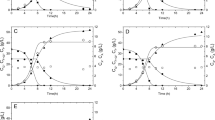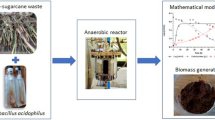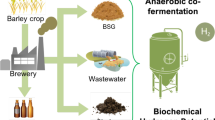Abstract
Brewers’ spent grain (BSG) liquor can be obtained by pressing fresh BSG and was recently proposed as a fermentation medium. A kinetic model was established, that can predict lactate formation and cell growth of Lactobacillus delbrueckii subsp. lactis with three BSG liquors of different origin in a simultaneous saccharification and fermentation approach. The kinetic model assumes a multi-substrate dependence of glucose and several nitrogen-containing molecule classes on cell growth, substrate uptake, and lactate formation. Furthermore, the model contains terms for the enzymatic degradation of 1,4-α-bond glucose oligomers. The nutrient content of the fermentation media, based on BSG liquor, varied broadly in terms of total carbohydrates (26.27 g·L−1 to 107.17 g·L−1), amino acids (1.52 g·L−1 to 6.78 g·L−1), and proteins (0.16 g·L−1 to 0.46 g·L−1). The deviation between experiment and simulation was — in relation to the large differences in media composition — quite small and ranged from 1.6% to 12.9% (final cell density) and from 5.0% to 24.8% (total lactate concentration). Both the experiment and the simulation showed that serine and alanine play an essential role in the metabolism of the organism. In general, the ratio of carbohydrates to amino acids in the fermentation medium is very important for L. delbrueckii subsp. lactis. Therefore, the model can contribute to control the bioprocess and assess fermentation kinetics for unknown BSG liquors.
Similar content being viewed by others
Abbreviations
- BSG:
-
Brewers’ spent grain
- CDW:
-
Cell dry weight
- DSMZ:
-
German Collection of Microorganisms and Cellcultures
- MRS:
-
Cultivation medium proposed by De Man, Rogosa, Sharpe
- N :
-
Stirrer speed
- OD600 :
-
Optical density measured at a wavelength of 600 nm
- PLA:
-
Poly lactic acid
- Q N2 :
-
Volumetric nitrogen flow
- RK4 :
-
4th order Runge-Kutta algorithm
- SSF:
-
Simultaneous saccharification and fermentation
- w%:
-
weight percentage
- AA_total :
-
Total (16) amino acids g·L−1
- Ala :
-
Alanine g·L−1
- f :
-
Dimensionless exponent n.a.
- h :
-
Dimensionless exponent n.a.
- k 1 :
-
Reaction constant of R1 h−1
- k 2 :
-
Reaction constant of R2 h−1
- k 3 :
-
Reaction constant of R3 h−1
- K AA_total :
-
Monod constant for amino acids g·L−1
- k Ala :
-
Reaction constant alanine h−1
- K Prot :
-
Monod constant for protein g·L−1
- K S4 :
-
Monod constant for glucose g·L−1
- K Ser :
-
Monod constant for serine g·L−1
- M :
-
Molecular weight g·mol−1
- P :
-
Product (lactate) g·L−1
- P m :
-
Inhibiting lactate concentration g·L−1
- P max :
-
Maximum lactate concentration g·L−1
- Prot :
-
Protein g·L−1
- R 1 :
-
Enzymatic reaction 1 n.a.
- R 2 :
-
Enzymatic reaction 2 n.a.
- R 3 :
-
Enzymatic reaction 3 n.a.
- r p :
-
Product (lactate) formation rate gLactate·gCDW−1·h−1
- S 1 :
-
Malto oligomers g·L−1
- S 12 :
-
Mass adjustment factor of R1 n.a.
- S 2 :
-
Maltotriose g·L−1
- S 23 :
-
Mass adjustment factor of R2 n.a.
- S 3 :
-
Maltose g·L−1
- S 34 :
-
Mass adjustment factor of R3 n.a.
- S 4 :
-
Glucose g·L−1
- Ser :
-
Serine g·L−1
- S_total :
-
Total carbohydrates g·L−1
- X :
-
Cell dry weight g·L−1
- X m :
-
Stationary cell concentration g·L−1
- X max :
-
Maximum cell concentration g·L−1
- Y P/X :
-
Lactate/biomass yield gLactate·gCDW−1
- Y X/AA_total :
-
Biomass/amino acids yield gCDW·gaminoacids−1
- Y X/Prot :
-
Biomass/protein yield gCDW·gProtein−1
- Y X/S4 :
-
Biomass/glucose yield gCDW·gGlucose−1
- Y X/Ser :
-
Biomass/serine yield gCDW·gSerine−1
- α :
-
Growth-coupled lactate formation coefficient gLactate·gCDW−1
- β :
-
Growth-uncoupled lactate formation coefficient gLactate·gCDW−1·h−1
- μ :
-
Growth rate h−1
- μ max :
-
Maximum specific growth rate h−1
References
Dosuky, A. S., F. N. Nasr, E. T. A. Yousef, and O. S. Barakat (2019) Bio-production of lactic acid from salted whey and whey permeate. Plant. Arch. 19: 793–798.
Dusselier, M., P. Van Wouwe, A. Dewaele, E. Makshinaa, and B. F. Sels (2013) Lactic acid as a platform chemical in the biobased economy: The role of chemocatalysis. Energy Environ. Sci. 6: 1415–1442.
Prasad, S., K. Srikanth, A. M. Limaye, and S. Sivaprakasam (2014) Homo-fermentative production of D-lactic acid by Lactobacillus sp. employing casein whey permeate as a raw feedstock. Biotechnol. Lett. 36: 1303–1307.
Reddy Tadi, S. R., A. E V R A. M. Limaye, and S. Sivaprakasam (2017) Enhanced production of optically pure d (-) lactic acid from nutritionally rich Borassus flabellifer sugar and whey protein hydrolysate based-fermentation medium. Biotechnol. Appl. Biochem. 63: 279–289.
Tanaka, T., M. Hoshina, S. Tanabe, K. Sakai, S. Ohtsubo, and M. Taniguchi (2006) Production of D-lactic acid from defatted rice bran by simultaneous saccharification and fermentation. Bioresour. Technol. 97: 211–217.
Akermann, A., J. Weiermüller, and R. Ulber (2019) Development of a biorefinery concept for brewers’ spent grain with a preliminary pressing step. Chem. Ing. Tech. 91: 1606–1614.
Akermann, A., J. Weiermüller, J. Christmann, L. Guirande, G. Glaser, A. Knaus, and R. Ulber (2020) Brewers’ spent grain liquor as a feedstock for lactate production with Lactobacillus delbrueckii subsp. lactis. Eng. Life Sci. 20: 168–180.
Tsuji, H. (2005) Poly (lactide) stereocomplexes: formation, structure, properties, degradation, and applications. Macromol. Biosci. 5: 569–597.
Wang, J. and W. Wan (2009) Kinetic models for fermentative hydrogen production: A review. Int. J. Hydrogen Energy. 34: 3313–3323.
Messens, W., J. Verluyten, F. Leroy, and L. De Vuyst (2003) Modelling growth and bacteriocin production by Lactobacillus curvatus LTH 1174 in response to temperature and pH values used for European sausage fermentation processes. Int. J. Food Microbiol. 81: 41–52.
Åkerberg, C., K. Hofvendahl, G. Zacchi, and B. Hahn-Hägerdal (1998) Modelling the influence of pH, temperature, glucose and lactic acid concentrations on the kinetics of lactic acid production by Lactococcus lactis ssp. lactis ATCC 19435 in whole-wheat flour. Appl. Microbiol. Biotechnol. 49: 682–690.
Amrane, A. (2001) Batch cultures of supplemented whey permeate using Lactobacillus helveticus: Unstructured model for biomass formation, substrate consumption and lactic acid production. Enzyme Microb. Technol. 28: 827–834.
Kulozik, U. and J. Wilde (1999) Rapid lactic acid production at high cell concentrations in whey ultrafiltrate by Lactobacillus helveticus. Enzyme Microb. Technol. 24: 297–302.
Monteagudo, J. M., L. Rodríguez, J. Rincón, and J. Fuertes (1997) Kinetics of lactic acid fermentation by Lactobacillus delbrueckii grown on beet molasses. J. Chem. Technol. Biotechnol. 68: 271–276.
Kumar Dutta, S., A. Mukherjee, and P. Chakraborty (1996) Effect of product inhibition on lactic acid fermentation: Simulation and modelling. Appl. Microbiol. Biotechnol. 46: 410–413.
Pleissner, D., F. Demichelis, S. Mariano, S. Fiore, I. M. N. Gutiérrez, R. Schneider, and J. Venus (2017) Direct production of lactic acid based on simultaneous saccharification and fermentation of mixed restaurant food waste. J. Clean Prod. 143: 615–623.
Hu, J., Y. Lin, Z. Zhang, T. Xiang, Y. Mei, S. Zhao, Y. Liang, and N. Peng (2016) High-titer lactic acid production by Lactobacillus pentosus FL0421 from corn stover using fed-batch simultaneous saccharification and fermentation. Bioresour. Technol. 214: 74–80.
De Man, J. C., M. Rogosa, and M. E. Sharpe (1960) A medium for the cultivation of Lactobacilli. J. Appl. Bacteriol. 23: 130–135.
Weiermüller, J., A. Akermann, T. Sieker, and R. Ulber (2020) Bioraffinerien auf Basis schwach verholzter Biomasse. Chem. Ing. Tech. 92: 1711–1722.
Lynch, K. M., E. J. Steffen, and E. K. Arendt (2016) Brewers’ spent grain: a review with an emphasis on food and health. J. Inst. Brew. 122: 553–568.
Goni, I., A. Garcia-Alonso, and F. Saura-Calixto (1997) A starch hydrolysis procedure to estimate glycemic index. Nutr. Res. 17: 427–437.
Schnell, S. and C. Mendoza (2004) The condition for pseudofirst-order kinetics in enzymatic reactions is independent of the initial enzyme concentration. Biophys. Chem. 107: 165–174.
Edwards, C. H., F. J. Warren, P. J. Milligan, P. J. Butterworth, and P. R. Ellis (2014) A novel method for classifying starch digestion by modelling the amylolysis of plant foods using first-order enzyme kinetic principles. Food Funct. 5: 2751–2758.
Altiok, D., F. Tokatli, and S. Harsa (2006) Kinetic modelling of lactic acid production from whey by Lactobacillus casei (NRRL B-441). J. Chem. Technol. Biotechnol. 81: 1190–1197.
Narziß, L. and W. Back (2009) Die Bierbrauerei: Band 2: Die Technologie der Würzebereitung. 8th ed., p. 254. Wiley-VCH, Weinheim, Germany.
Liu, E., H. Zheng, P. Hao, T. Konno, Y. Yu, H. Kume, M. Oda, and Z. S. Ji (2012) A model of proteolysis and amino acid biosynthesis for Lactobacillus delbrueckii subsp. bulgaricus in whey. Curr. Microbiol. 65: 742–751.
Berry, A. R., C. M. M. Franco, W. Zhang, and A. P. J. Middelberg (1999) Growth and lactic acid production in batch culture of Lactobacillus rhamnosus in a defined medium. Biotechnol. Lett. 21: 163–167.
Levenspiel, O. (1980) The monod equation: A revisit and a generalization to product inhibition situations. Biotechnol. Bioeng. 22: 1671–1687.
Gänzle, M. G. (2015) Lactic metabolism revisited: Metabolism of lactic acid bacteria in food fermentations and food spoilage. Curr. Opin. Food Sci. 2: 106–117.
Buchholz, J., M. Graf, B. Blombach, and R. Takors (2014) Improving the carbon balance of fermentations by total carbon analyses. Biochem. Eng. J. 90: 162–169.
Burgos-Rubio, C. N., M. R. Okos, and P. C. Wankat (2000) Kinetic study of the conversion of different substrates to lactic acid using Lactobacillus bulgaricus. Biotechnol. Prog. 16: 305–314.
Youssef, C. B., G. Goma, and A. Olmos-Dichara (2005) Kinetic modelling of Lactobacillus casei ssp. rhamnosus growth and lactic acid production in batch cultures under various medium conditions. Biotechnol. Lett. 27: 1785–1789.
Polakovič, M. and J. Bryjak (2004) Modelling of potato starch saccharification by an Aspergillus niger glucoamylase. Biochem. Eng. J. 18: 57–63.
Kunji, E. R., I. Mierau, A. Hagting, B. Poolman, and W. N. Konings (1996) The proteolytic systems of lactic acid bacteria. Antonie van Leeuwenhoek. 70: 187–221.
Acknowledgments
This research was performed as a part of the European Union project BIOVAL, which is funded by the European Regional Development Fund EFRE-interreg (018-4-09-021). We wish to express our gratitude for financial support. Special thanks goes to the Novozymes A/S for suppling the glucoamylase mixture Attenuzyme® Core.
The authors declare no conflict of interest.
No ethical approval required.
No informed consent required.
Author information
Authors and Affiliations
Corresponding author
Additional information
Publisher’s Note Springer Nature remains neutral with regard to jurisdictional claims in published maps and institutional affiliations.
Electronic Supplementary Material
Rights and permissions
About this article
Cite this article
Akermann, A., Weiermüller, J., Lenz, S. et al. Kinetic Model for Simultaneous Saccharification and Fermentation of Brewers’ Spent Grain Liquor Using Lactobacillus delbrueckii Subsp. lactis. Biotechnol Bioproc E 26, 114–124 (2021). https://doi.org/10.1007/s12257-020-0153-z
Received:
Revised:
Accepted:
Published:
Issue Date:
DOI: https://doi.org/10.1007/s12257-020-0153-z




